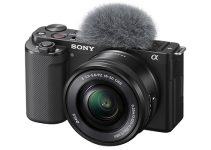The Z Cam E2 – a 4K camera with interchangeable, high frame rate recording, 10-bit, modular design with ProRes inside. Sounds good, so why have we never heard of it?
Z Cam are a Chinese VR company who launched the Z Cam E1 in 2015 and again, nobody seemed to hear about that. New cameras seem to pop up quite regularly nowadays from manufacturers across the globe. Some are successful like the Blackmagic Design cameras that really shook up the industry a few years ago, while some like the Fran 8K haven’t fared quite so well. Short-lived projects live the Digital Bolex relied on name recognition and successful Kickstarter campaign to get going but didn’t work out in the end.
Somewhere in the middle are the brands that have a lot of promise but are competing against some heavyweight competition like Kinefinity vs. RED.
This is a tough market to break into and having the backing of a huge, established company gives some cameras a chance to find their feet, just ask Sony and Panasonic. Even then it doesn’t always work out, we’re looking at you Samsung.
Have a look at this video clip for a bit more about the camera, it’s not the best quality and it’s a bit long but worth a wee look.
Here are some headlines about the Z Cam e2:
It is small and lightweight and has a somewhat modular design. It utilises some popular i/o on the back to attach a monitor, stream footage, add an XLR break-out cable and so the actual box is quite little.
It is a 4/3” sensor and Micro 4/3’s lens mount. That would set it in the Blackmagic Pocket Cinema Camera 4K or GH5 territory with regards to crop factor and lens choice. Only some lenses are supported in the system to check out the website to see what they are – http://www.z-cam.com/e2/
It records in 4K and at some high frame-rates. In HD it can record up to 240fps and in 4K up to 120fps and this is pretty amazing. Well done to Z Cam for bringing such high speeds to such a small and affordable camera.
It doesn’t have a usable monitor, just a small screen for settings like a DSLR might, it does actually show your image but is so small it’s totally impractical for monitoring. You can attach a phone or external monitor and plenty choices are available from people like Small HD and they can attach via HDMI, SDI or USB-C.
It records to CFast cards or via USB-c to an external SSD. ProRes seems to be the format of choice for Z Cam.
It can handle audio, somewhat. It has a mini-jack for headphones, a mini-jack for an external mic like a Rode Videomic and a mini-jack for an optional XLR break-out cable that offers phantom power. These are all fine, but are perhaps not pro-level options that would make this a rounded camera.
The footage in the video above doesn’t really show the camera at its best, for that I would suggest a trip to the Z Cam website, but it is interesting to see it out there in a shooter’s hands. Would I buy this camera? Not yet. If the company can continue and develop further in the next few years then it might become a viable option but they are up against some stiff competition.
These kinds of cameras are a risky proposition not just for the manufacturer but for the buyer. Servicing and reliability are big question marks as there simply aren’t enough of them out there to gauge. The features that this camera offers are available in better-established cameras, or close to them, like the Panasonic GH5 line or the Blackmagic Pocket Cinema Camera 4K. As such, I would mark the Z Cam as a curiosity worth keeping an eye on in the future.
[source: Jamal Mortimer]
Disclaimer: As an Amazon Associate partner and participant in B&H and Adorama Affiliate programmes, we earn a small comission from each purchase made through the affiliate links listed above at no additional cost to you.


